Paper Menu >>
Journal Menu >>
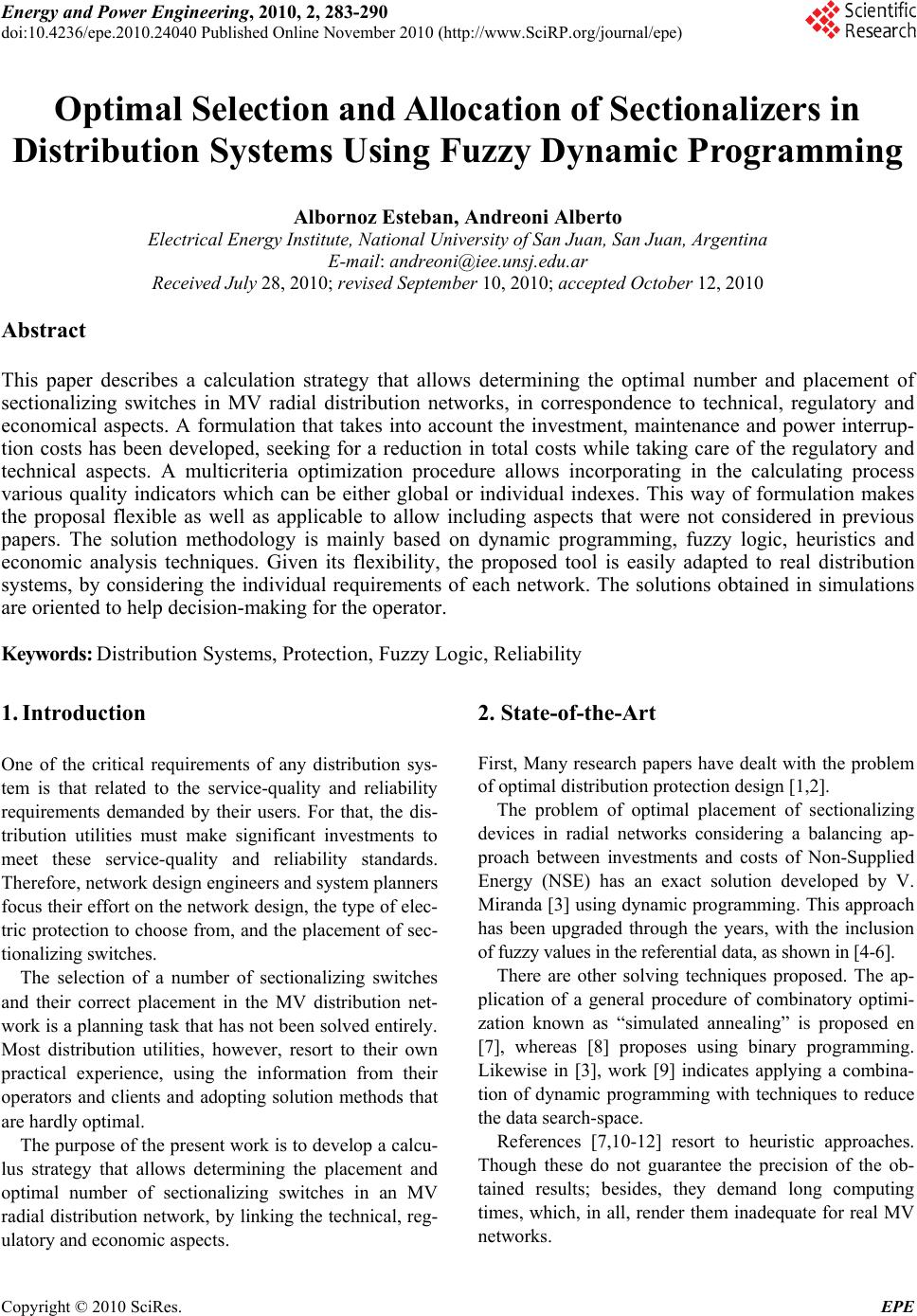 Energy and Power Engineering, 2010, 2, 283-290 doi:10.4236/epe.2010.24040 Published Online November 2010 (http://www.SciRP.org/journal/epe) Copyright © 2010 SciRes. EPE Optimal Selection and Allocation of Sectionalizers in Distribution Systems Using Fuzzy Dynamic Programming Albornoz Esteban, Andreoni Alberto Electrical Energy Institute, National University of San Juan, San Juan, Argentina E-mail: andreoni@iee.unsj.edu.ar Received July 28, 2010; revised September 10, 2010; accepted October 12, 2010 Abstract This paper describes a calculation strategy that allows determining the optimal number and placement of sectionalizing switches in MV radial distribution networks, in correspondence to technical, regulatory and economical aspects. A formulation that takes into account the investment, maintenance and power interrup- tion costs has been developed, seeking for a reduction in total costs while taking care of the regulatory and technical aspects. A multicriteria optimization procedure allows incorporating in the calculating process various quality indicators which can be either global or individual indexes. This way of formulation makes the proposal flexible as well as applicable to allow including aspects that were not considered in previous papers. The solution methodology is mainly based on dynamic programming, fuzzy logic, heuristics and economic analysis techniques. Given its flexibility, the proposed tool is easily adapted to real distribution systems, by considering the individual requirements of each network. The solutions obtained in simulations are oriented to help decision-making for the operator. Keywords: Distribution Systems, Protection, Fuzzy Logic, Reliability 1. Introduction One of the critical requirements of any distribution sys- tem is that related to the service-quality and reliability requirements demanded by their users. For that, the dis- tribution utilities must make significant investments to meet these service-quality and reliability standards. Therefore, network design engineers and system planners focus their effort on the network design, the type of elec- tric protection to choose from, and the placement of sec- tionalizing switches. The selection of a number of sectionalizing switches and their correct placement in the MV distribution net- work is a planning task that has not been solved entirely. Most distribution utilities, however, resort to their own practical experience, using the information from their operators and clients and adopting solution methods that are hardly optimal. The purpose of the present work is to develop a calcu- lus strategy that allows determining the placement and optimal number of sectionalizing switches in an MV radial distribution network, by linking the technical, reg- ulatory and economic aspects. 2. State-of-the-Art First, Many research papers have dealt with the problem of optimal distribution protection design [1,2]. The problem of optimal placement of sectionalizing devices in radial networks considering a balancing ap- proach between investments and costs of Non-Supplied Energy (NSE) has an exact solution developed by V. Miranda [3] using dynamic programming. This approach has been upgraded through the years, with the inclusion of fuzzy values in the referential data, as shown in [4-6]. There are other solving techniques proposed. The ap- plication of a general procedure of combinatory optimi- zation known as “simulated annealing” is proposed en [7], whereas [8] proposes using binary programming. Likewise in [3], work [9] indicates applying a combina- tion of dynamic programming with techniques to reduce the data search-space. References [7,10-12] resort to heuristic approaches. Though these do not guarantee the precision of the ob- tained results; besides, they demand long computing times, which, in all, render them inadequate for real MV networks. 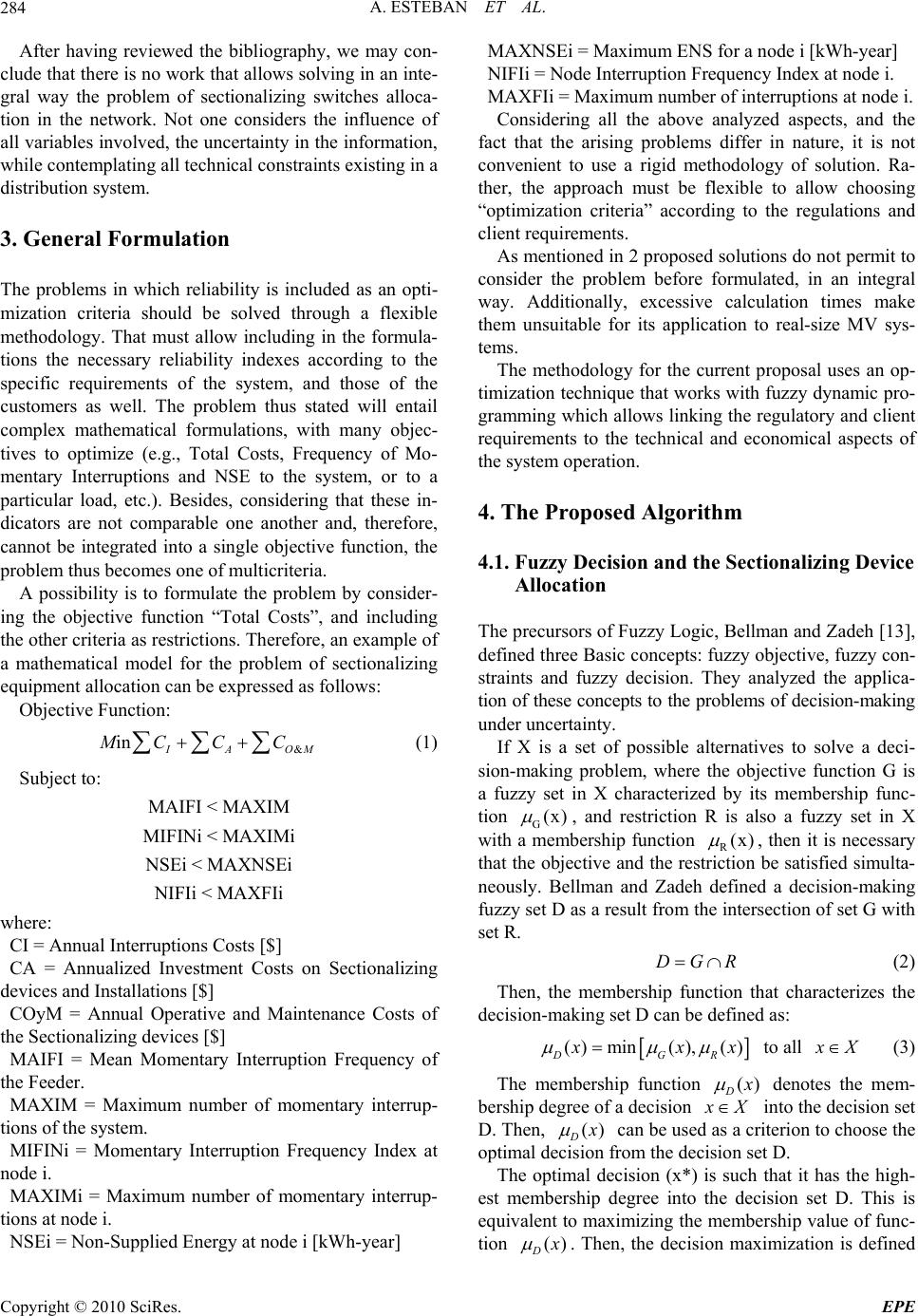 A. ESTEBAN ET AL. Copyright © 2010 SciRes. EPE 284 After having reviewed the bibliography, we may con- clude that there is no work that allows solving in an inte- gral way the problem of sectionalizing switches alloca- tion in the network. Not one considers the influence of all variables involved, the uncertainty in the information, while contemplating all technical constraints existing in a distribution system. 3. General Formulation The problems in which reliability is included as an opti- mization criteria should be solved through a flexible methodology. That must allow including in the formula- tions the necessary reliability indexes according to the specific requirements of the system, and those of the customers as well. The problem thus stated will entail complex mathematical formulations, with many objec- tives to optimize (e.g., Total Costs, Frequency of Mo- mentary Interruptions and NSE to the system, or to a particular load, etc.). Besides, considering that these in- dicators are not comparable one another and, therefore, cannot be integrated into a single objective function, the problem thus becomes one of multicriteria. A possibility is to formulate the problem by consider- ing the objective function “Total Costs”, and including the other criteria as restrictions. Therefore, an example of a mathematical model for the problem of sectionalizing equipment allocation can be expressed as follows: Objective Function: & in I AOM MC CC (1) Subject to: MAIFI < MAXIM MIFINi < MAXIMi NSEi < MAXNSEi NIFIi < MAXFIi where: CI = Annual Interruptions Costs [$] CA = Annualized Investment Costs on Sectionalizing devices and Installations [$] COyM = Annual Operative and Maintenance Costs of the Sectionalizing devices [$] MAIFI = Mean Momentary Interruption Frequency of the Feeder. MAXIM = Maximum number of momentary interrup- tions of the system. MIFINi = Momentary Interruption Frequency Index at node i. MAXIMi = Maximum number of momentary interrup- tions at node i. NSEi = Non-Supplied Energy at node i [kWh-year] MAXNSEi = Maximum ENS for a node i [kWh-year] NIFIi = Node Interruption Frequency Index at node i. MAXFIi = Maximum number of interruptions at node i. Considering all the above analyzed aspects, and the fact that the arising problems differ in nature, it is not convenient to use a rigid methodology of solution. Ra- ther, the approach must be flexible to allow choosing “optimization criteria” according to the regulations and client requirements. As mentioned in 2 proposed solutions do not permit to consider the problem before formulated, in an integral way. Additionally, excessive calculation times make them unsuitable for its application to real-size MV sys- tems. The methodology for the current proposal uses an op- timization technique that works with fuzzy dynamic pro- gramming which allows linking the regulatory and client requirements to the technical and economical aspects of the system operation. 4. The Proposed Algorithm 4.1. Fuzzy Decision and the Sectionalizing Device Allocation The precursors of Fuzzy Logic, Bellman and Zadeh [13], defined three Basic concepts: fuzzy objective, fuzzy con- straints and fuzzy decision. They analyzed the applica- tion of these concepts to the problems of decision-making under uncertainty. If X is a set of possible alternatives to solve a deci- sion-making problem, where the objective function G is a fuzzy set in X characterized by its membership func- tion G(x) , and restriction R is also a fuzzy set in X with a membership function R(x) , then it is necessary that the objective and the restriction be satisfied simulta- neously. Bellman and Zadeh defined a decision-making fuzzy set D as a result from the intersection of set G with set R. DGR (2) Then, the membership function that characterizes the decision-making set D can be defined as: () min(),() DGR x xx to all x X (3) The membership function () D x denotes the mem- bership degree of a decision x X into the decision set D. Then, () D x can be used as a criterion to choose the optimal decision from the decision set D. The optimal decision (x*) is such that it has the high- est membership degree into the decision set D. This is equivalent to maximizing the membership value of func- tion () D x . Then, the decision maximization is defined 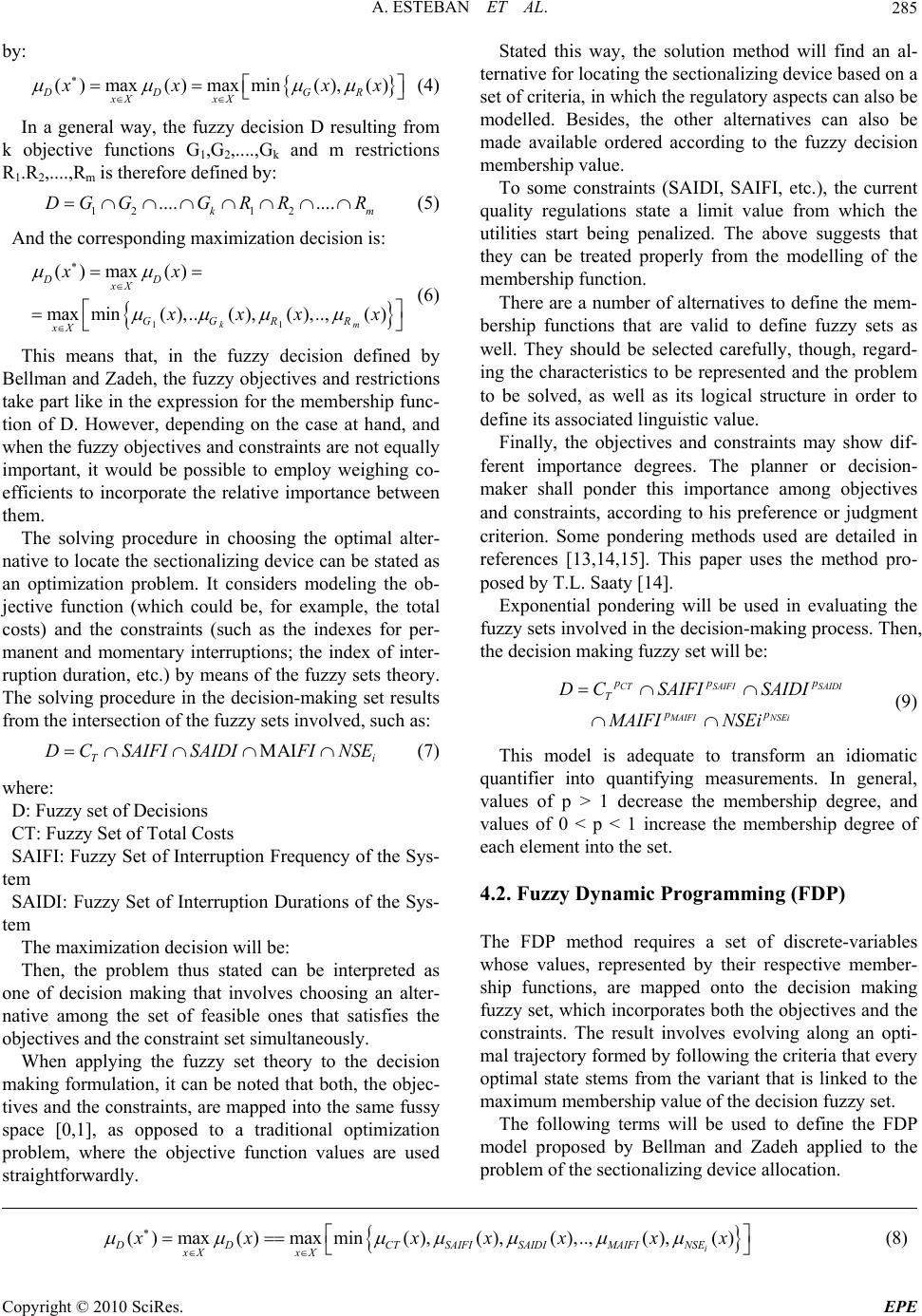 A. ESTEBAN ET AL. Copyright © 2010 SciRes. EPE 285 by: ()max()maxmin(),( ) DD GR xX xX x xxx (4) In a general way, the fuzzy decision D resulting from k objective functions G1,G2,....,Gk and m restrictions R1.R2,....,Rm is therefore defined by: 12 12 .... .... km DG GGRRR (5) And the corresponding maximization decision is: 11 ()max () maxmin( ),..( ),(),..,( ) km DD xX GGRR xX xx x xx x (6) This means that, in the fuzzy decision defined by Bellman and Zadeh, the fuzzy objectives and restrictions take part like in the expression for the membership func- tion of D. However, depending on the case at hand, and when the fuzzy objectives and constraints are not equally important, it would be possible to employ weighing co- efficients to incorporate the relative importance between them. The solving procedure in choosing the optimal alter- native to locate the sectionalizing device can be stated as an optimization problem. It considers modeling the ob- jective function (which could be, for example, the total costs) and the constraints (such as the indexes for per- manent and momentary interruptions; the index of inter- ruption duration, etc.) by means of the fuzzy sets theory. The solving procedure in the decision-making set results from the intersection of the fuzzy sets involved, such as: Ti DCSAIFI SAIDIFINSE (7) where: D: Fuzzy set of Decisions CT: Fuzzy Set of Total Costs SAIFI: Fuzzy Set of Interruption Frequency of the Sys- tem SAIDI: Fuzzy Set of Interruption Durations of the Sys- tem The maximization decision will be: Then, the problem thus stated can be interpreted as one of decision making that involves choosing an alter- native among the set of feasible ones that satisfies the objectives and the constraint set simultaneously. When applying the fuzzy set theory to the decision making formulation, it can be noted that both, the objec- tives and the constraints, are mapped into the same fussy space [0,1], as opposed to a traditional optimization problem, where the objective function values are used straightforwardly. Stated this way, the solution method will find an al- ternative for locating the sectionalizing device based on a set of criteria, in which the regulatory aspects can also be modelled. Besides, the other alternatives can also be made available ordered according to the fuzzy decision membership value. To some constraints (SAIDI, SAIFI, etc.), the current quality regulations state a limit value from which the utilities start being penalized. The above suggests that they can be treated properly from the modelling of the membership function. There are a number of alternatives to define the mem- bership functions that are valid to define fuzzy sets as well. They should be selected carefully, though, regard- ing the characteristics to be represented and the problem to be solved, as well as its logical structure in order to define its associated linguistic value. Finally, the objectives and constraints may show dif- ferent importance degrees. The planner or decision- maker shall ponder this importance among objectives and constraints, according to his preference or judgment criterion. Some pondering methods used are detailed in references [13,14,15]. This paper uses the method pro- posed by T.L. Saaty [14]. Exponential pondering will be used in evaluating the fuzzy sets involved in the decision-making process. Then, the decision making fuzzy set will be: CT SAIFISAIDI NSEi MAIFI pp p T p p DC SAIFISAIDI MAIFI NSEi (9) This model is adequate to transform an idiomatic quantifier into quantifying measurements. In general, values of p > 1 decrease the membership degree, and values of 0 < p < 1 increase the membership degree of each element into the set. 4.2. Fuzzy Dynamic Programming (FDP) The FDP method requires a set of discrete-variables whose values, represented by their respective member- ship functions, are mapped onto the decision making fuzzy set, which incorporates both the objectives and the constraints. The result involves evolving along an opti- mal trajectory formed by following the criteria that every optimal state stems from the variant that is linked to the maximum membership value of the decision fuzzy set. The following terms will be used to define the FDP model proposed by Bellman and Zadeh applied to the problem of the sectionalizing device allocation. ()max( )maxmin( ),(),( ),..,( ),( ) i DDCT SAIFI SAIDIMAIFI NSE xX xX x xxxxxx (8) 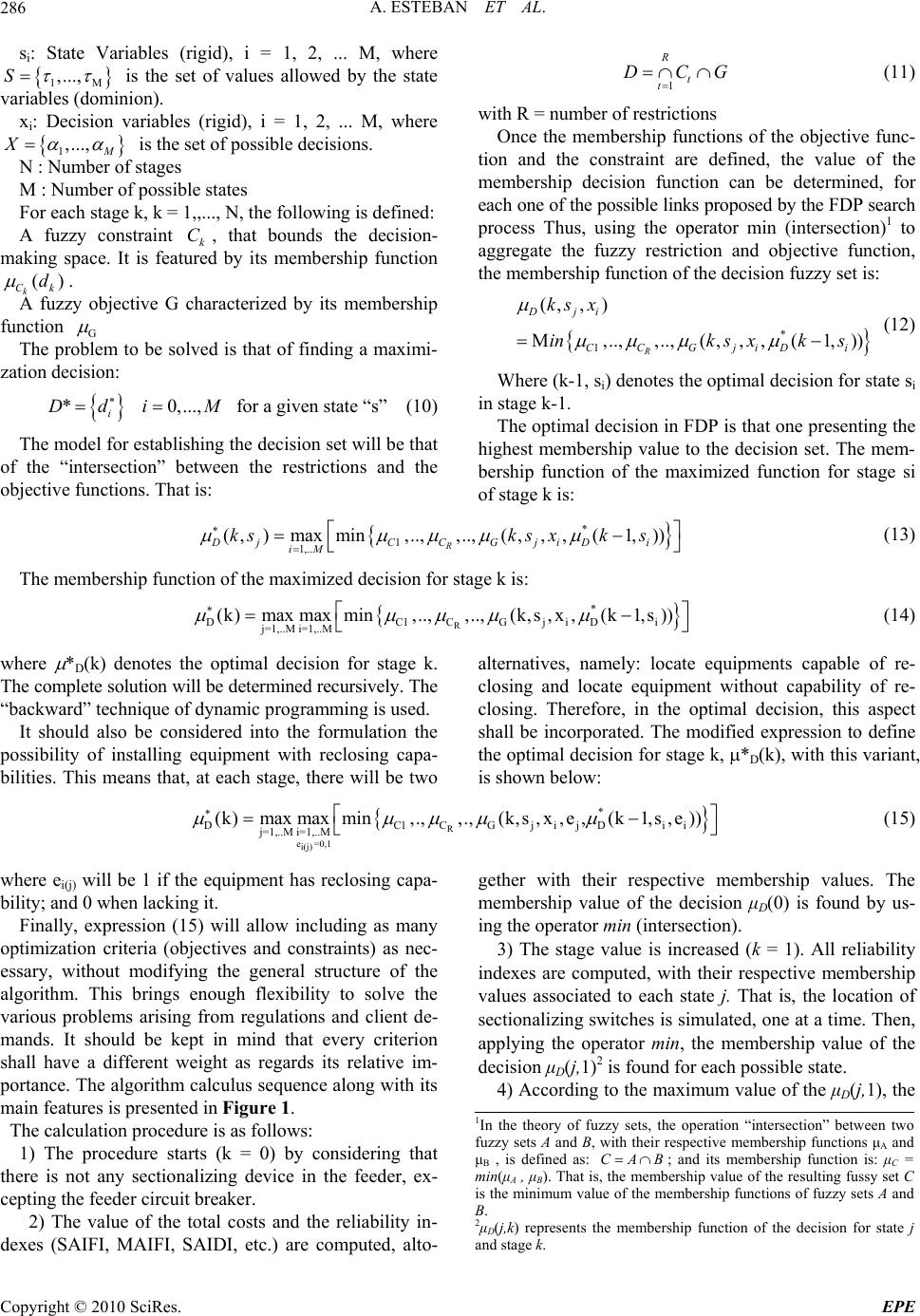 A. ESTEBAN ET AL. Copyright © 2010 SciRes. EPE 286 si: State Variables (rigid), i = 1, 2, ... M, where 1,...,S is the set of values allowed by the state variables (dominion). xi: Decision variables (rigid), i = 1, 2, ... M, where 1,..., M X is the set of possible decisions. N : Number of stages M : Number of possible states For each stage k, k = 1,,..., N, the following is defined: A fuzzy constraint k C, that bounds the decision- making space. It is featured by its membership function () k Ck d . A fuzzy objective G characterized by its membership function G The problem to be solved is that of finding a maximi- zation decision: * 0,..., i Ddi M for a given state “s” (10) The model for establishing the decision set will be that of the “intersection” between the restrictions and the objective functions. That is: 1 R t t DCG (11) with R = number of restrictions Once the membership functions of the objective func- tion and the constraint are defined, the value of the membership decision function can be determined, for each one of the possible links proposed by the FDP search process Thus, using the operator min (intersection)1 to aggregate the fuzzy restriction and objective function, the membership function of the decision fuzzy set is: * 1 (,,) ,..,,..,( ,,,(1,)) R Dji CCGjiD i ks x ink sxks (12) Where (k-1, si) denotes the optimal decision for state si in stage k-1. The optimal decision in FDP is that one presenting the highest membership value to the decision set. The mem- bership function of the maximized function for stage si of stage k is: * 1 1,.. ( ,)maxmin,..,,..,( ,,,(1,)) R DjC CGjiDi iM ksks xks (13) The membership function of the maximized decision for stage k is: R * DC1CGjiDi j=1,..M i=1,..M (k)maxmaxmin,..,,..,(k,s,x,(k1,s)) (14) where *D(k) denotes the optimal decision for stage k. The complete solution will be determined recursively. The “backward” technique of dynamic programming is used. It should also be considered into the formulation the possibility of installing equipment with reclosing capa- bilities. This means that, at each stage, there will be two alternatives, namely: locate equipments capable of re- closing and locate equipment without capability of re- closing. Therefore, in the optimal decision, this aspect shall be incorporated. The modified expression to define the optimal decision for stage k, *D(k), with this variant, is shown below: R e=0,1 i(j) * DC1CGjijDii j=1,..M i=1,..M (k)maxmaxmin,.,,.,(k,s,x,e,(k1,s,e)) (15) where ei(j) will be 1 if the equipment has reclosing capa- bility; and 0 when lacking it. Finally, expression (15) will allow including as many optimization criteria (objectives and constraints) as nec- essary, without modifying the general structure of the algorithm. This brings enough flexibility to solve the various problems arising from regulations and client de- mands. It should be kept in mind that every criterion shall have a different weight as regards its relative im- portance. The algorithm calculus sequence along with its main features is presented in Figure 1. The calculation procedure is as follows: 1) The procedure starts (k = 0) by considering that there is not any sectionalizing device in the feeder, ex- cepting the feeder circuit breaker. 2) The value of the total costs and the reliability in- dexes (SAIFI, MAIFI, SAIDI, etc.) are computed, alto- gether with their respective membership values. The membership value of the decision μD(0) is found by us- ing the operator min (intersection). 3) The stage value is increased (k = 1). All reliability indexes are computed, with their respective membership values associated to each state j. That is, the location of sectionalizing switches is simulated, one at a time. Then, applying the operator min, the membership value of the decision μD(j,1)2 is found for each possible state. 4) According to the maximum value of the μD(j,1), the 1In the theory of fuzzy sets, the operation “intersection” between two fuzzy sets A and B, with their respective membership functions μAand μB , is defined as: CAB ; and its membership function is: μC = min(μA , μB). That is, the membership value of the resulting fussy set C is the minimum value of the membership functions of fuzzy sets Aand B . 2μD(j,k) represents the membership function of the decision for state j and stage k. 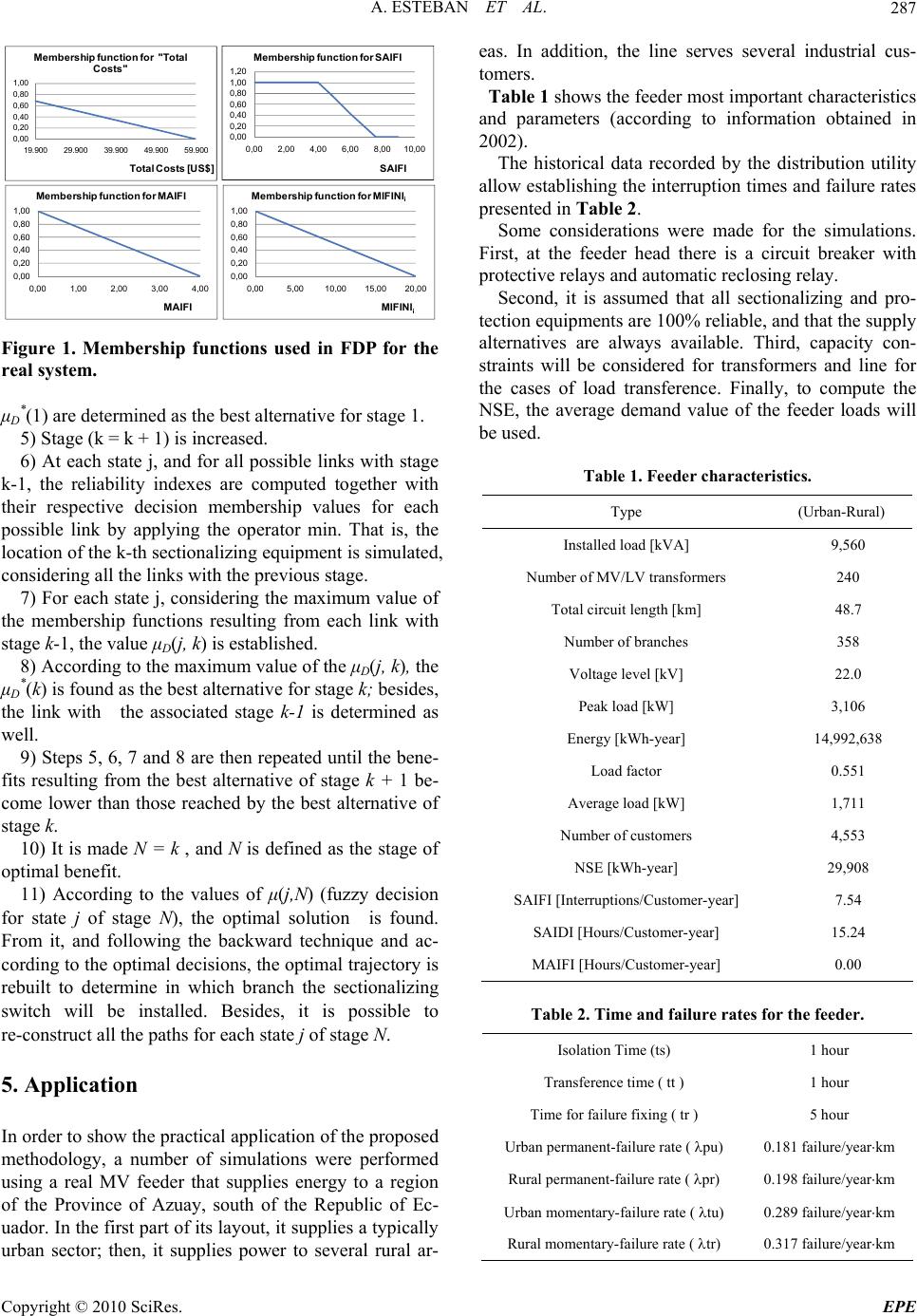 A. ESTEBAN ET AL. Copyright © 2010 SciRes. EPE 287 0,00 0,20 0,40 0,60 0,80 1,00 1,20 0,00 2,00 4,00 6,00 8,0010,00 SAIFI Membership function for SAIFI 0,00 0,20 0,40 0,60 0,80 1,00 0,005,0010,00 15,00 20,00 MIFINI i Membership function for MIFINI i 0,00 0,20 0,40 0,60 0,80 1,00 0,00 1,00 2,00 3,00 4,00 MAIFI Membership function for MAIFI 0,00 0,20 0,40 0,60 0,80 1,00 19.900 29.900 39.900 49.900 59.900 Total Costs [US$] Membership function for "Total Costs" Figure 1. Membership functions used in FDP for the real system. μD *(1) are determined as the best alternative for stage 1. 5) Stage (k = k + 1) is increased. 6) At each state j, and for all possible links with stage k-1, the reliability indexes are computed together with their respective decision membership values for each possible link by applying the operator min. That is, the location of the k-th sectionalizing equipment is simulated, considering all the links with the previous stage. 7) For each state j, considering the maximum value of the membership functions resulting from each link with stage k-1, the value μD(j, k) is established. 8) According to the maximum value of the μD(j, k), the μD *(k) is found as the best alternative for stage k; besides, the link with the associated stage k-1 is determined as well. 9) Steps 5, 6, 7 and 8 are then repeated until the bene- fits resulting from the best alternative of stage k + 1 be- come lower than those reached by the best alternative of stage k. 10) It is made N = k , and N is defined as the stage of optimal benefit. 11) According to the values of μ(j,N) (fuzzy decision for state j of stage N), the optimal solution is found. From it, and following the backward technique and ac- cording to the optimal decisions, the optimal trajectory is rebuilt to determine in which branch the sectionalizing switch will be installed. Besides, it is possible to re-construct all the paths for each state j of stage N. 5. Application In order to show the practical application of the proposed methodology, a number of simulations were performed using a real MV feeder that supplies energy to a region of the Province of Azuay, south of the Republic of Ec- uador. In the first part of its layout, it supplies a typically urban sector; then, it supplies power to several rural ar- eas. In addition, the line serves several industrial cus- tomers. Table 1 shows the feeder most important characteristics and parameters (according to information obtained in 2002). The historical data recorded by the distribution utility allow establishing the interruption times and failure rates presented in Table 2. Some considerations were made for the simulations. First, at the feeder head there is a circuit breaker with protective relays and automatic reclosing relay. Second, it is assumed that all sectionalizing and pro- tection equipments are 100% reliable, and that the supply alternatives are always available. Third, capacity con- straints will be considered for transformers and line for the cases of load transference. Finally, to compute the NSE, the average demand value of the feeder loads will be used. Table 1. Feeder characteristics. Type (Urban-Rural) Installed load [kVA] 9,560 Number of MV/LV transformers 240 Total circuit length [km] 48.7 Number of branches 358 Voltage level [kV] 22.0 Peak load [kW] 3,106 Energy [kWh-year] 14,992,638 Load factor 0.551 Average load [kW] 1,711 Number of customers 4,553 NSE [kWh-year] 29,908 SAIFI [Interruptions/Customer-year] 7.54 SAIDI [Hours/Customer-year] 15.24 MAIFI [Hours/Customer-year] 0.00 Table 2. Time and failure rates for the feeder. Isolation Time (ts) 1 hour Transference time ( tt ) 1 hour Time for failure fixing ( tr ) 5 hour Urban permanent-failure rate ( pu) 0.181 failure/yearkm Rural permanent-failure rate ( pr) 0.198 failure/yearkm Urban momentary-failure rate ( tu) 0.289 failure/yearkm Rural momentary-failure rate ( tr) 0.317 failure/yearkm 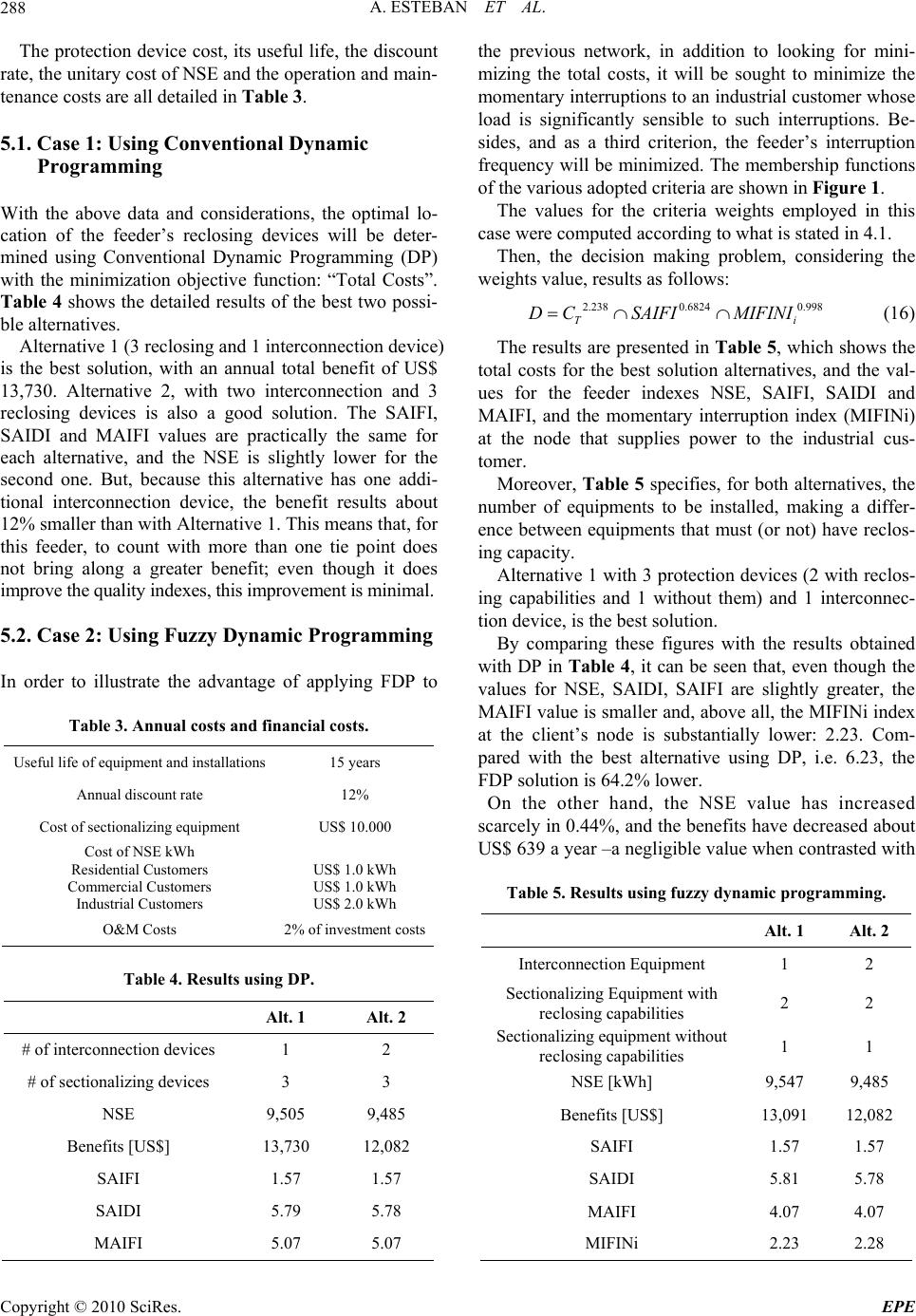 A. ESTEBAN ET AL. Copyright © 2010 SciRes. EPE 288 The protection device cost, its useful life, the discount rate, the unitary cost of NSE and the operation and main- tenance costs are all detailed in Table 3. 5.1. Case 1: Using Conventional Dynamic Programming With the above data and considerations, the optimal lo- cation of the feeder’s reclosing devices will be deter- mined using Conventional Dynamic Programming (DP) with the minimization objective function: “Total Costs”. Table 4 shows the detailed results of the best two possi- ble alternatives. Alternative 1 (3 reclosing and 1 interconnection device) is the best solution, with an annual total benefit of US$ 13,730. Alternative 2, with two interconnection and 3 reclosing devices is also a good solution. The SAIFI, SAIDI and MAIFI values are practically the same for each alternative, and the NSE is slightly lower for the second one. But, because this alternative has one addi- tional interconnection device, the benefit results about 12% smaller than with Alternative 1. This means that, for this feeder, to count with more than one tie point does not bring along a greater benefit; even though it does improve the quality indexes, this improvement is minimal. 5.2. Case 2: Using Fuzzy Dynamic Programming In order to illustrate the advantage of applying FDP to Table 3. Annual costs and financial costs. Useful life of equipment and installations 15 years Annual discount rate 12% Cost of sectionalizing equipment US$ 10.000 Cost of NSE kWh Residential Customers Commercial Customers Industrial Customers US$ 1.0 kWh US$ 1.0 kWh US$ 2.0 kWh O&M Costs 2% of investment costs Table 4. Results using DP. Alt. 1 Alt. 2 # of interconnection devices 1 2 # of sectionalizing devices 3 3 NSE 9,505 9,485 Benefits [US$] 13,730 12,082 SAIFI 1.57 1.57 SAIDI 5.79 5.78 MAIFI 5.07 5.07 the previous network, in addition to looking for mini- mizing the total costs, it will be sought to minimize the momentary interruptions to an industrial customer whose load is significantly sensible to such interruptions. Be- sides, and as a third criterion, the feeder’s interruption frequency will be minimized. The membership functions of the various adopted criteria are shown in Figure 1. The values for the criteria weights employed in this case were computed according to what is stated in 4.1. Then, the decision making problem, considering the weights value, results as follows: 2.238 0.68240.998 Ti D CSAIFIMIFINI (16) The results are presented in Table 5, which shows the total costs for the best solution alternatives, and the val- ues for the feeder indexes NSE, SAIFI, SAIDI and MAIFI, and the momentary interruption index (MIFINi) at the node that supplies power to the industrial cus- tomer. Moreover, Table 5 specifies, for both alternatives, the number of equipments to be installed, making a differ- ence between equipments that must (or not) have reclos- ing capacity. Alternative 1 with 3 protection devices (2 with reclos- ing capabilities and 1 without them) and 1 interconnec- tion device, is the best solution. By comparing these figures with the results obtained with DP in Table 4, it can be seen that, even though the values for NSE, SAIDI, SAIFI are slightly greater, the MAIFI value is smaller and, above all, the MIFINi index at the client’s node is substantially lower: 2.23. Com- pared with the best alternative using DP, i.e. 6.23, the FDP solution is 64.2% lower. On the other hand, the NSE value has increased scarcely in 0.44%, and the benefits have decreased about US$ 639 a year –a negligible value when contrasted with Table 5. Results using fuzzy dynamic programming. Alt. 1 Alt. 2 Interconnection Equipment 1 2 Sectionalizing Equipment with reclosing capabilities 2 2 Sectionalizing equipment without reclosing capabilities 1 1 NSE [kWh] 9,547 9,485 Benefits [US$] 13,091 12,082 SAIFI 1.57 1.57 SAIDI 5.81 5.78 MAIFI 4.07 4.07 MIFINi 2.23 2.28 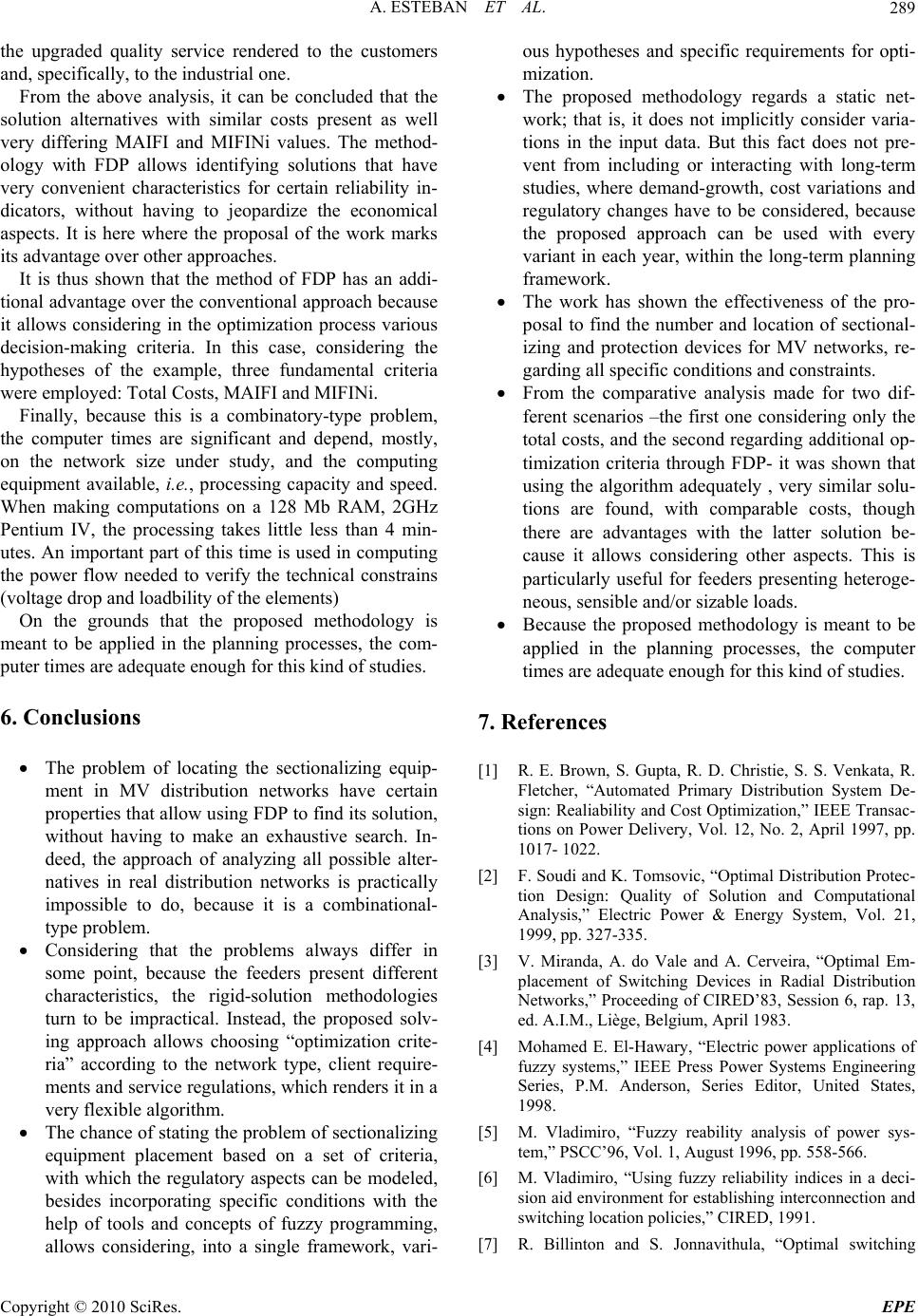 A. ESTEBAN ET AL. Copyright © 2010 SciRes. EPE 289 the upgraded quality service rendered to the customers and, specifically, to the industrial one. From the above analysis, it can be concluded that the solution alternatives with similar costs present as well very differing MAIFI and MIFINi values. The method- ology with FDP allows identifying solutions that have very convenient characteristics for certain reliability in- dicators, without having to jeopardize the economical aspects. It is here where the proposal of the work marks its advantage over other approaches. It is thus shown that the method of FDP has an addi- tional advantage over the conventional approach because it allows considering in the optimization process various decision-making criteria. In this case, considering the hypotheses of the example, three fundamental criteria were employed: Total Costs, MAIFI and MIFINi. Finally, because this is a combinatory-type problem, the computer times are significant and depend, mostly, on the network size under study, and the computing equipment available, i.e., processing capacity and speed. When making computations on a 128 Mb RAM, 2GHz Pentium IV, the processing takes little less than 4 min- utes. An important part of this time is used in computing the power flow needed to verify the technical constrains (voltage drop and loadbility of the elements) On the grounds that the proposed methodology is meant to be applied in the planning processes, the com- puter times are adequate enough for this kind of studies. 6. Conclusions The problem of locating the sectionalizing equip- ment in MV distribution networks have certain properties that allow using FDP to find its solution, without having to make an exhaustive search. In- deed, the approach of analyzing all possible alter- natives in real distribution networks is practically impossible to do, because it is a combinational- type problem. Considering that the problems always differ in some point, because the feeders present different characteristics, the rigid-solution methodologies turn to be impractical. Instead, the proposed solv- ing approach allows choosing “optimization crite- ria” according to the network type, client require- ments and service regulations, which renders it in a very flexible algorithm. The chance of stating the problem of sectionalizing equipment placement based on a set of criteria, with which the regulatory aspects can be modeled, besides incorporating specific conditions with the help of tools and concepts of fuzzy programming, allows considering, into a single framework, vari- ous hypotheses and specific requirements for opti- mization. The proposed methodology regards a static net- work; that is, it does not implicitly consider varia- tions in the input data. But this fact does not pre- vent from including or interacting with long-term studies, where demand-growth, cost variations and regulatory changes have to be considered, because the proposed approach can be used with every variant in each year, within the long-term planning framework. The work has shown the effectiveness of the pro- posal to find the number and location of sectional- izing and protection devices for MV networks, re- garding all specific conditions and constraints. From the comparative analysis made for two dif- ferent scenarios –the first one considering only the total costs, and the second regarding additional op- timization criteria through FDP- it was shown that using the algorithm adequately , very similar solu- tions are found, with comparable costs, though there are advantages with the latter solution be- cause it allows considering other aspects. This is particularly useful for feeders presenting heteroge- neous, sensible and/or sizable loads. Because the proposed methodology is meant to be applied in the planning processes, the computer times are adequate enough for this kind of studies. 7. References [1] R. E. Brown, S. Gupta, R. D. Christie, S. S. Venkata, R. Fletcher, “Automated Primary Distribution System De- sign: Realiability and Cost Optimization,” IEEE Transac- tions on Power Delivery, Vol. 12, No. 2, April 1997, pp. 1017- 1022. [2] F. Soudi and K. Tomsovic, “Optimal Distribution Protec- tion Design: Quality of Solution and Computational Analysis,” Electric Power & Energy System, Vol. 21, 1999, pp. 327-335. [3] V. Miranda, A. do Vale and A. Cerveira, “Optimal Em- placement of Switching Devices in Radial Distribution Networks,” Proceeding of CIRED’83, Session 6, rap. 13, ed. A.I.M., Liège, Belgium, April 1983. [4] Mohamed E. El-Hawary, “Electric power applications of fuzzy systems,” IEEE Press Power Systems Engineering Series, P.M. Anderson, Series Editor, United States, 1998. [5] M. Vladimiro, “Fuzzy reability analysis of power sys- tem,” PSCC’96, Vol. 1, August 1996, pp. 558-566. [6] M. Vladimiro, “Using fuzzy reliability indices in a deci- sion aid environment for establishing interconnection and switching location policies,” CIRED, 1991. [7] R. Billinton and S. Jonnavithula, “Optimal switching 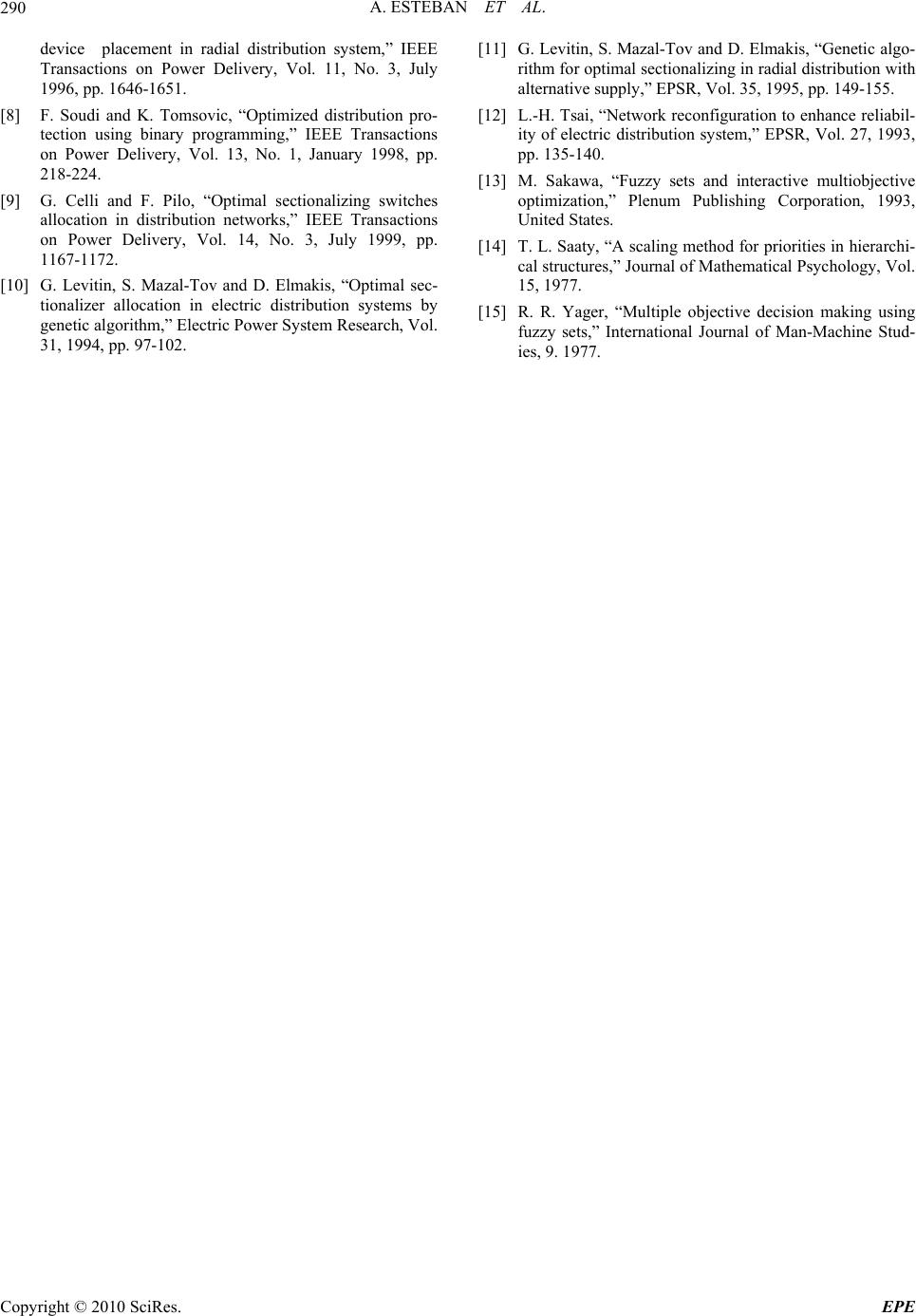 A. ESTEBAN ET AL. Copyright © 2010 SciRes. EPE 290 device placement in radial distribution system,” IEEE Transactions on Power Delivery, Vol. 11, No. 3, July 1996, pp. 1646-1651. [8] F. Soudi and K. Tomsovic, “Optimized distribution pro- tection using binary programming,” IEEE Transactions on Power Delivery, Vol. 13, No. 1, January 1998, pp. 218-224. [9] G. Celli and F. Pilo, “Optimal sectionalizing switches allocation in distribution networks,” IEEE Transactions on Power Delivery, Vol. 14, No. 3, July 1999, pp. 1167-1172. [10] G. Levitin, S. Mazal-Tov and D. Elmakis, “Optimal sec- tionalizer allocation in electric distribution systems by genetic algorithm,” Electric Power System Research, Vol. 31, 1994, pp. 97-102. [11] G. Levitin, S. Mazal-Tov and D. Elmakis, “Genetic algo- rithm for optimal sectionalizing in radial distribution with alternative supply,” EPSR, Vol. 35, 1995, pp. 149-155. [12] L.-H. Tsai, “Network reconfiguration to enhance reliabil- ity of electric distribution system,” EPSR, Vol. 27, 1993, pp. 135-140. [13] M. Sakawa, “Fuzzy sets and interactive multiobjective optimization,” Plenum Publishing Corporation, 1993, United States. [14] T. L. Saaty, “A scaling method for priorities in hierarchi- cal structures,” Journal of Mathematical Psychology, Vol. 15, 1977. [15] R. R. Yager, “Multiple objective decision making using fuzzy sets,” International Journal of Man-Machine Stud- ies, 9. 1977. |

